Early Literacy Aside--Explain: Rhyming is one of the things that children learn that lets them hear that words are made of smaller parts. By doing rhyming songs and fingerplays with your child, you are supporting phonlogical awareness. It's fun for you and your child and will help them when it comes time for them to sound out words when they learn to read. Submitted by Molly Beedon, Ypsilanti (MI) District Library
Bear Wants More by Karma Wilson

Submitted by Rhonda Butler, Public Libraries of Saginaw (MI)
Wide-Mouthed Frog by Keith Faulkner
 Early Literacy Aside--Example: Print motivation is an interest in and enjoyment of books. Children need this skill prior to formal reading instruction. One way to develop this skill is to use pop-up books and other books that provide surprises. Let's see what surprises this book brings.Read Wide-Mouthed Frog.
Early Literacy Aside--Example: Print motivation is an interest in and enjoyment of books. Children need this skill prior to formal reading instruction. One way to develop this skill is to use pop-up books and other books that provide surprises. Let's see what surprises this book brings.Read Wide-Mouthed Frog.
Submitted by Lisa Watson, Flat River (MI) Community Library
Candlewick Press Storytime Plan
Storytime Plan includes these books with suggested activities and relation to the early literacy skills.Arabella Miller's Tiny Caterpiller by Clare Jarrett On the Farm by David Elliott A Visitor for Bear by Bonny Becker Tweedle Dee Dee by Charlotte Voake [Some activities are more for school-age children.] readtousstoryhourkit.pdf
Orange Pear Apple Bear by Emily Gravett
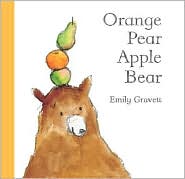
Re-tell the story using flannel pieces with the children telling the story as you put the pieces on the board. As the whole story has four words the children learn it quickly. This book can also be used to demonstrate narrative skills.
Submitted by Leslee Farish Kuykendal, Chicago Public Library
Little Raindrops Fingerplay
Fingerplay: Little Raindrops
This is the sun, high up in the sky. (Form large circle with arms up)
A dark cloud suddenly comes sailing by. (Move hands through the air in a parallel motion.)
These are the raindrops, pitter, pattering down. (Bring arms down, flutter fingers)
Watering the flowers, growing on the ground. (Cup hands to form flowers.)
Activity: Make a book based on this fingerplay. Use the pattern here (Little Raindrops Booklet pattern) to represent the items in the fingerplay. There are four pages for your book (one for each line of the fingerplay). The pattern is a Word document so you can change the size of the objects to save paper, if you wish. The children cut out the pictures. They can cut around them to make it easier. The adults write the words to the fingerplay on each page. For children too young for this craft, the adults make the book FOR their young children. The umbrella can be used on the cover of the book.
Early Literacy Aside--Empower: Making a book with or for your child is very special. By showing care in making them and including your child in the process you make this activity around a book enjoyable. Your child can memorize the words to the rhyme and can "pretend" read it to you. Praise your child. This helps develop print motivation, a child's interest and enjoyment of books and reading. OR Making a book with your child shows them how books work. This helps them with print awareness, how to handle a book, which will get them comfortable with using books as they learn to read. Submitted by Jaime Duval and Whitney Whitaker, Radford (VA) Public Library
Rain by Robert Kalan
 Read the book Rain by Robert KalanEarly Literacy Aside--Example: It is really important for children to be able to tell and re-tell stories or ideas in chronological order. We are going to use this flannel board (Rain flannel board) to let the children re-tell the story we just read. Plus, they will see how each item affects the next one. This activity will help them develop their narrative skills which later helps them understand what they read.
Flannel Board: Place pieces on the flannel board as the children retell the story.
You can use some of the pieces from the flannel board pattern as a handout so that the children can retell the story at home.
Submitted by Jaime Duval and Whitney Whitaker, Radford (VA) Public Library
Read the book Rain by Robert KalanEarly Literacy Aside--Example: It is really important for children to be able to tell and re-tell stories or ideas in chronological order. We are going to use this flannel board (Rain flannel board) to let the children re-tell the story we just read. Plus, they will see how each item affects the next one. This activity will help them develop their narrative skills which later helps them understand what they read.
Flannel Board: Place pieces on the flannel board as the children retell the story.
You can use some of the pieces from the flannel board pattern as a handout so that the children can retell the story at home.
Submitted by Jaime Duval and Whitney Whitaker, Radford (VA) Public Library
Mouse Mess by Linnea Riley
 Book Introduction: Our next story is Mouse Mess by Linnea Riley. Notice the words on boxes and bottles as Mouse finds food to eat.
Read the book, saying the words on the boxes and bottles as you point to them.
Early Literacy Aside--Example: Pointing out the words we see on boxes and bottles is one way to help children develop one of the early literacy skills, print awareness, understanding that print has meaning.
Activity: At the end of storytime put out cereal boxes, bottles, any containers with writing on it and let the children "read" them.
Early Literacy Aside--Empower: Don't forget, when you go shopping or are just out and about, talk with your children about the signs and labels they see, just as we did with Mouse Mess. This is one simple way to develop your children's print awareness.
Book Introduction: Our next story is Mouse Mess by Linnea Riley. Notice the words on boxes and bottles as Mouse finds food to eat.
Read the book, saying the words on the boxes and bottles as you point to them.
Early Literacy Aside--Example: Pointing out the words we see on boxes and bottles is one way to help children develop one of the early literacy skills, print awareness, understanding that print has meaning.
Activity: At the end of storytime put out cereal boxes, bottles, any containers with writing on it and let the children "read" them.
Early Literacy Aside--Empower: Don't forget, when you go shopping or are just out and about, talk with your children about the signs and labels they see, just as we did with Mouse Mess. This is one simple way to develop your children's print awareness.
Very Busy Spider by Eric Carle
 Talk about spiders and how they spin their webs. Each web is different. They use their webs to catch their food.Read the book The Very Busy Spider by Eric Carle.
Put up pieces on a flannel board, having the participants retell the story as you put up the pieces.
Early Literacy Aside--Example: This book has lots of repetition so it is a good one for retelling. I have a handout with the same figures that I used on the flannel board. I will also pass out some yarn to make the web. You can cut out the figures and use the yarn to retell the story. Helping your children to retell stories will help them understand what they read later in school.
Talk about spiders and how they spin their webs. Each web is different. They use their webs to catch their food.Read the book The Very Busy Spider by Eric Carle.
Put up pieces on a flannel board, having the participants retell the story as you put up the pieces.
Early Literacy Aside--Example: This book has lots of repetition so it is a good one for retelling. I have a handout with the same figures that I used on the flannel board. I will also pass out some yarn to make the web. You can cut out the figures and use the yarn to retell the story. Helping your children to retell stories will help them understand what they read later in school.
Figures for flannel board and handout verybusyspiderpatterns.doc [For the flannel board, an alternative to using the cutout figure of the spider is to make a spider by stapling two small paper plates together. Cut strips of black construction paper and attach to paper plates for legs. Slip yarn between the stapled paper plates with a bit sticking out to start the web. Pull out the yarn as you make the web on the flannel board. If you need to you can use velcro or pins or tacks to hold the yarn to the flannel board. Tell the children that spiders don't need that--the web itself is sticky.]
I Ain't Gonna Paint No More by Karen Beaumont
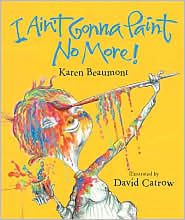
Submitted by Katie Ross, Kanawha County (WV) Public Library System
You Can Do Anything, Daddy by Michael Rex
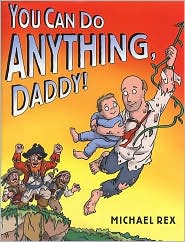
The Art Box by Gail Gibbons
 Before reading the book: Ask the children to describe things they would put in a box. And in this box it will contain art supplies. What can you think of? They reply with crayons, paint, etc. This is a great way for children to use the vocabulary that they do know and also good for developing Narrative Skills, which is the ability to describe events and tell stories. Now let's see how a book can help introduce children to new vocabulary.Read the book Art Box by Gail Gibbons.
Have items like compass, protractor, etc. available for the children to see and use. Talk about what they do.
Early Literacy Aside--Empower: Parents, having real objects to help children understand words in the book is one way to help build their vocabulary, to learn the meanings of words. Even when you are not reading books, just talking about objects around the house and what they do is one way to expand children's understanding.
Before reading the book: Ask the children to describe things they would put in a box. And in this box it will contain art supplies. What can you think of? They reply with crayons, paint, etc. This is a great way for children to use the vocabulary that they do know and also good for developing Narrative Skills, which is the ability to describe events and tell stories. Now let's see how a book can help introduce children to new vocabulary.Read the book Art Box by Gail Gibbons.
Have items like compass, protractor, etc. available for the children to see and use. Talk about what they do.
Early Literacy Aside--Empower: Parents, having real objects to help children understand words in the book is one way to help build their vocabulary, to learn the meanings of words. Even when you are not reading books, just talking about objects around the house and what they do is one way to expand children's understanding.
Submitted by Katie Ross, Kanawha County (WV) Public Library System
You Can Do Anything, Daddy by Michael Rex
[Notice how the fonts for what the boy says and what the father says are different.]Read the book You Can Do Anything Daddy by Michael Rex. Point to some of the words that are in large type (gorilla, robot, Mars) Early Literacy Aside--Example: I pointed to some of the words in the book, the ones with larger type, as I read them. This helps children understand that it is the words we are reading, which develops print awareness, one of the skills children need for later reading.
Tippy-Toe Chick, Go! by George Shannon
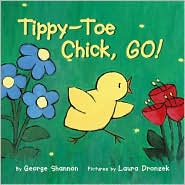
Tippy-Toe Chick, Go! by George Shannon
Early Literacy Aside--Explain: Letting your children know when you really enjoy a book helps them see your own enjoyment. Even doing this small thing helps develop print motivation, a child's interest and enjoyment of books and reading.Early Literacy Aside--Example: Our next book is funny and clever. I enjoy this book because the little chick is the one who is so smart! Listen to what happens. Read the book Tippy-Toe Chick, Go! by George Shannon. [For more participation, which also supports print motivation, have the participants chime in for RUFF-RUFF and tippy-toe, tippy-toe.]
Don't Worry Bear by Greg Foley
 Book Introduction: Our next book is Don't Worry Bear by Greg Foley. [Run your finger under the title.] In this book the caterpillar says the words "Don't worry, bear" over and over again. Let's practice saying that--"Don't worry. bear." Good! . . .As I read the book, I'll point to you all and you'll know to say, "Don't worry, bear." [As you read the book run your finger under the words don't worry bear, as they say these words.]
Early Literacy Aside--Example: You noticed that I ran my finger under the words don't worry bear each time you all said those words. This helps develop your children's print awareness, knowing that print has meaning and that it is the words we read. You can do this with any book you read!
Book Introduction: Our next book is Don't Worry Bear by Greg Foley. [Run your finger under the title.] In this book the caterpillar says the words "Don't worry, bear" over and over again. Let's practice saying that--"Don't worry. bear." Good! . . .As I read the book, I'll point to you all and you'll know to say, "Don't worry, bear." [As you read the book run your finger under the words don't worry bear, as they say these words.]
Early Literacy Aside--Example: You noticed that I ran my finger under the words don't worry bear each time you all said those words. This helps develop your children's print awareness, knowing that print has meaning and that it is the words we read. You can do this with any book you read!
Don't Worry Bear by Greg Foley
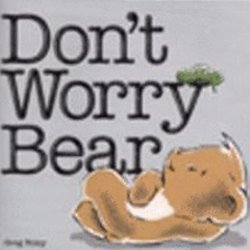
Don't Worry Bear by Greg Foley
Before reading the book talk about caterpillars and how they grow. Ask questions to see what the children already know.Read the title, Don't Worry Bear, and tell the group that these words are repeated throughout the book. Let's say them all together, "Don't worry, bear." The caterpillar keeps saying "Don't worry, bear," and you will say it each time. Let's try it. Read the book Don't Worry Bear by Greg Foley. Early Literacy Aside--Example: Having the children repeat a phrase in the book is the beginning of developing your children's narrative skills. The next step is to have your child retell the story to you. This later helps with your child understanding what he will read when he gets to school.
Buzz, Buzz, Buzz! Went Bumblebee by Colin West
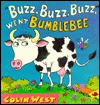 Early Literacy Aside--Explain: Narrative skills can be developed by having your children tell stories. This is easier for some children when they recognize patterns so that they can predict what will happen next.Early Literacy Aside--Example: As we read the book we want to encourage our children to recognize the pattern and to repeat "buzz, buzz, buzz" and "buzz off."
Read Buzz, Buzz, Buzz! Went Bumble-bee by Colin West
Fingerplay: Here is the Beehive
Here is the beehive. Where are the bees? (Hold up fist.)
Hidden away where nobody sees. (Move other hand around fist.)
Watch and you see them come out of the hive. (Bend head close to fist.)
One, two, three, four, five. (Hold fingers up one at a time.)
Bzzzzzzzz all fly away! (Wave fingers.)
Early Literacy Aside--Empower: Children enjoy repeating phrases as they did in our book and song. Please help your children look for patterns in the books and songs you do at home. This helps foster your children's narrative skills which will later help them understand how stories work and will help them understand what they read.
Early Literacy Aside--Explain: Narrative skills can be developed by having your children tell stories. This is easier for some children when they recognize patterns so that they can predict what will happen next.Early Literacy Aside--Example: As we read the book we want to encourage our children to recognize the pattern and to repeat "buzz, buzz, buzz" and "buzz off."
Read Buzz, Buzz, Buzz! Went Bumble-bee by Colin West
Fingerplay: Here is the Beehive
Here is the beehive. Where are the bees? (Hold up fist.)
Hidden away where nobody sees. (Move other hand around fist.)
Watch and you see them come out of the hive. (Bend head close to fist.)
One, two, three, four, five. (Hold fingers up one at a time.)
Bzzzzzzzz all fly away! (Wave fingers.)
Early Literacy Aside--Empower: Children enjoy repeating phrases as they did in our book and song. Please help your children look for patterns in the books and songs you do at home. This helps foster your children's narrative skills which will later help them understand how stories work and will help them understand what they read.
Who's There on Halloween? by Pamela Beall

Song: Do a rhyming song to the tune of Are You Sleeping? We are rhyming; we are rhyming. Rhyme with me; rhyme with me. Nose rhymes with toes; nose rhymes with toes. (substitute other words from story) Rhyme with me; rhyme with me. Early Literacy Aside--Empower: Take advantage of lots of opportunities to play rhyming games with your children. Simple activities like this will help your child be able to sound out words when they learn to read.
Submitted by participants in Saskatchewan Library Association Conference
